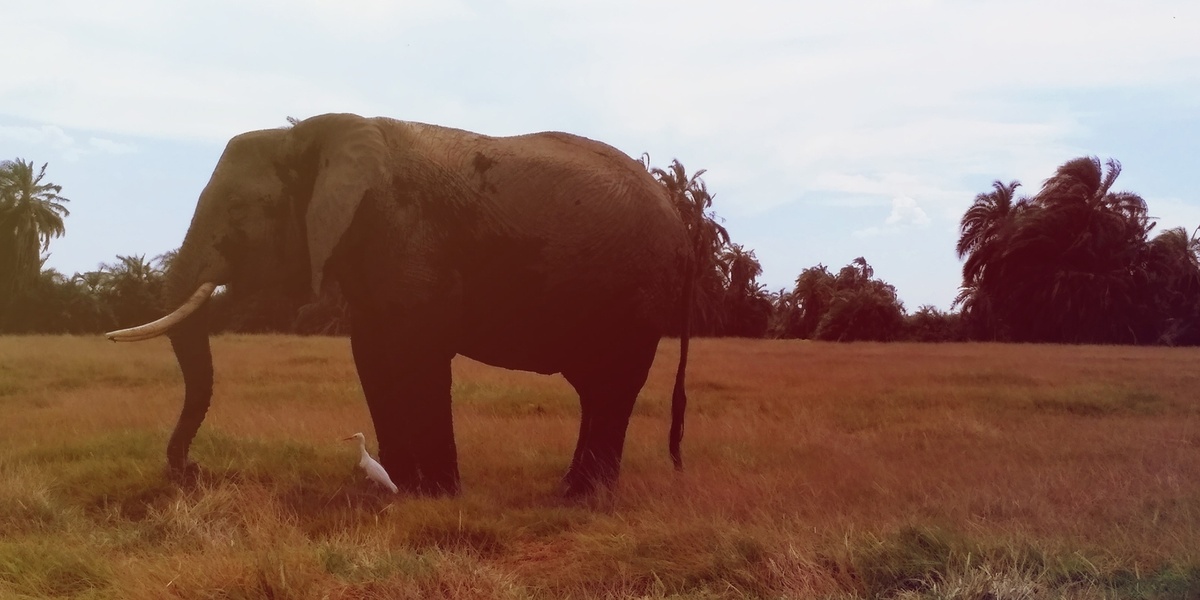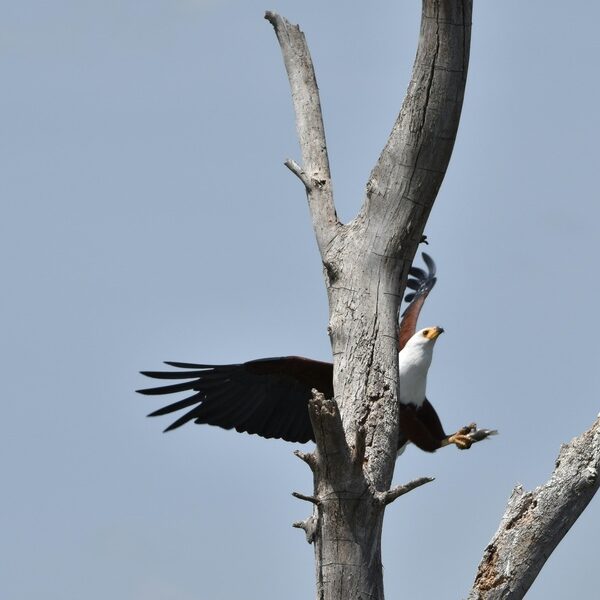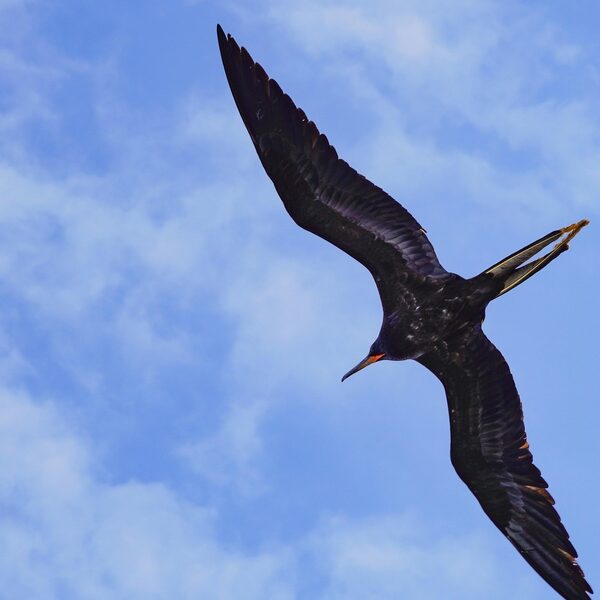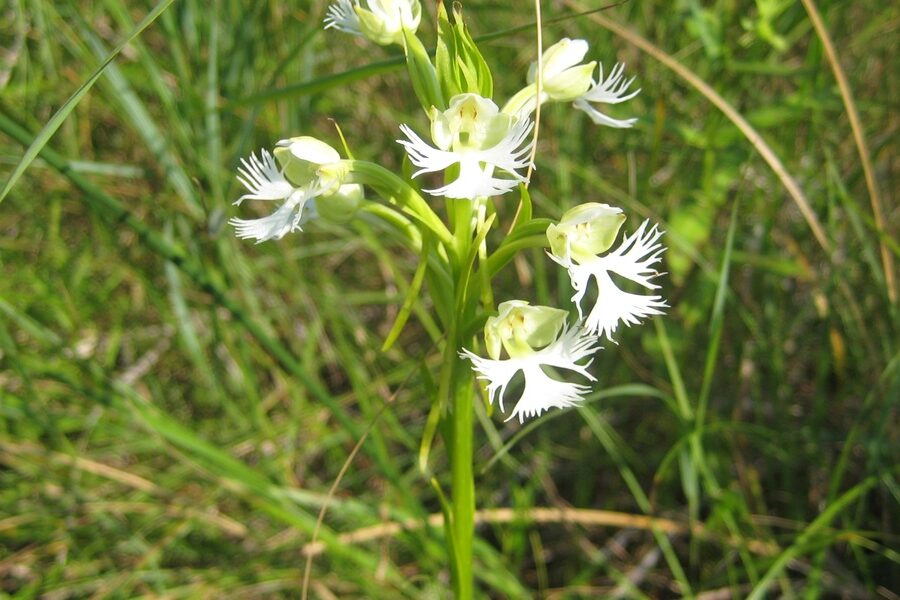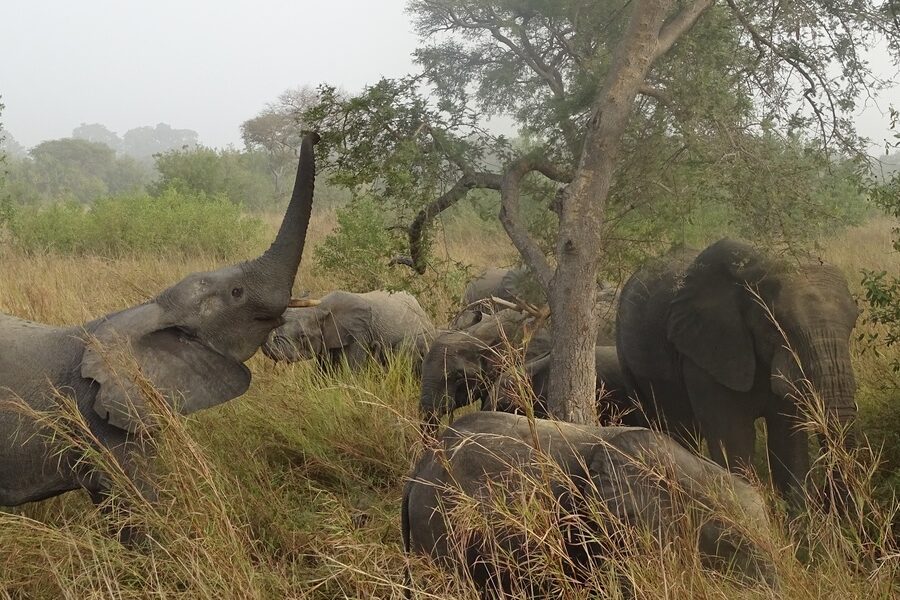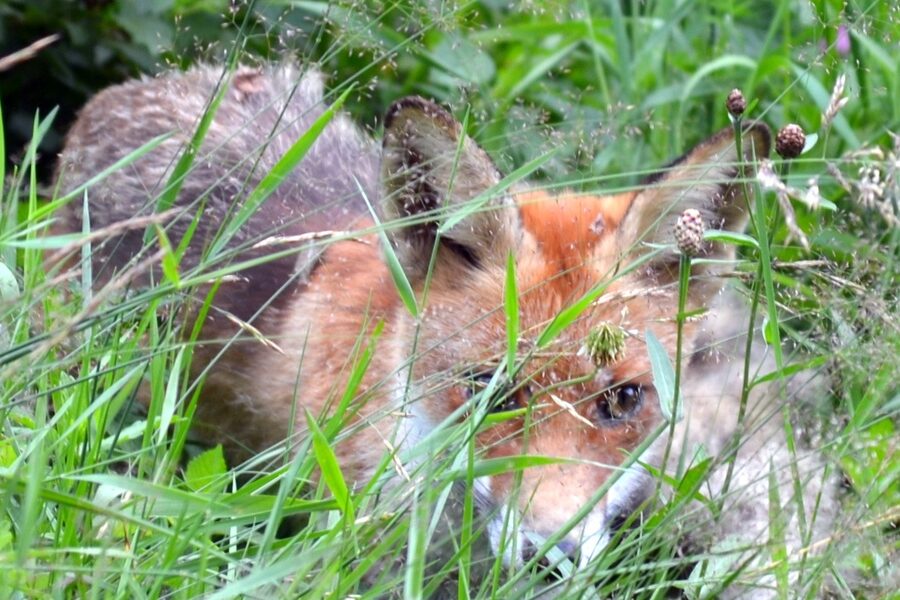Tanzania’s varied landscapes—from coastal mangroves and savannas to montane forests and the Rift Valley—support a huge diversity of mammals. Whether you’re a researcher, guide, or curious traveler, a clear species list helps make sense of where animals occur and how they’re faring.
There are 88 Mammals of Tanzania, ranging from Aardvark to Zorilla. For each species you’ll find below the Scientific name,IUCN status,Distribution and habitat so you can quickly scan taxonomy, conservation status and typical locations you’ll find below.
How current is the information and where do the IUCN statuses come from?
The IUCN statuses are drawn from the most recent assessments available but assessment dates vary by species; consider this list a compiled snapshot and check the IUCN Red List or recent regional surveys for updates before making management decisions.
Can I use this list to plan wildlife viewing or conservation work?
Yes—as a starting checklist it’s useful for planning, but for fieldwork or travel you should pair it with local seasonal guides, park-specific species lists, up-to-date distribution maps, and advice from local guides or conservation agencies.
Mammals of Tanzania
| Name | Scientific name | IUCN status | Distribution and habitat |
|---|---|---|---|
| Lion | Panthera leo | Vulnerable | Serengeti, Ngorongoro, Ruaha; savanna and open woodland. |
| Leopard | Panthera pardus | Vulnerable | Widespread in parks like Serengeti, Ruaha, Selous; woodland, riverine forest, hills. |
| African Elephant | Loxodonta africana | Endangered | Serengeti, Tarangire, Ruaha, Selous; wide-ranging in savanna, forest, and bushland. |
| Black Rhinoceros | Diceros bicornis | Critically Endangered | Ngorongoro Crater, Serengeti, Selous; dense bush and savanna. |
| African Buffalo | Syncerus caffer | Near Threatened | Widespread in Serengeti, Tarangire, Katavi; savanna and floodplain with water access. |
| Cheetah | Acinonyx jubatus | Vulnerable | Serengeti, Ruaha, Ngorongoro Conservation Area; open grasslands and savanna. |
| African Wild Dog | Lycaon pictus | Endangered | Selous (Nyerere NP), Ruaha; savanna, open woodland, and grasslands. |
| Masai Giraffe | Giraffa tippelskirchi | Endangered | Serengeti, Tarangire, Arusha NP; savanna and open woodlands. |
| Hippopotamus | Hippopotamus amphibius | Vulnerable | Abundant in rivers and pools in Selous, Ruaha, Katavi; aquatic habitats. |
| Plains Zebra | Equus quagga | Near Threatened | Serengeti, Ngorongoro, Tarangire; grasslands and savanna woodlands. |
| Blue Wildebeest | Connochaetes taurinus | Least Concern | Serengeti, Ngorongoro; short-grass plains and savanna. |
| Spotted Hyena | Crocuta crocuta | Least Concern | Serengeti, Ngorongoro, Selous; widespread in savanna, woodland, and semi-desert. |
| Chimpanzee | Pan troglodytes | Endangered | Gombe Stream and Mahale Mountains National Parks; tropical forest. |
| Yellow Baboon | Papio cynocephalus | Least Concern | Ruaha, Selous, Mikumi; savanna and open woodland. |
| Olive Baboon | Papio anubis | Least Concern | Serengeti, Lake Manyara, Gombe; savanna, woodland, and steppe. |
| Vervet Monkey | Chlorocebus pygerythrus | Least Concern | Widespread in many parks; savanna, riverine forest, and woodland. |
| Blue Monkey | Cercopithecus mitis | Least Concern | Arusha NP, Lake Manyara, Mahale Mountains; montane and riverine forests. |
| Angolan Colobus | Colobus angolensis | Least Concern | Amani Nature Reserve, Udzungwa Mountains; montane and coastal forests. |
| Udzungwa Red Colobus | Piliocolobus gordonorum | Endangered | Udzungwa Mountains National Park and surrounding forests; montane forest. |
| Sanje Mangabey | Cercocebus sanjei | Endangered | Udzungwa Mountains National Park; montane forest. |
| Common Eland | Taurotragus oryx | Least Concern | Serengeti, Ruaha, Katavi; grassland, savanna, and montane moorland. |
| Greater Kudu | Tragelaphus strepsiceros | Least Concern | Ruaha, Selous, Katavi; woodland and bushland with thick cover. |
| Sable Antelope | Hippotragus niger | Least Concern | Ruaha, Katavi, Selous; miombo woodland and savanna. |
| Roan Antelope | Hippotragus equinus | Least Concern | Ruaha, Katavi, Burigi-Chato; open or lightly wooded grassland. |
| Waterbuck | Kobus ellipsiprymnus | Least Concern | Widespread near water in Selous, Ruaha, Serengeti; riverine areas and floodplains. |
| Topi | Damaliscus lunatus jimela | Least Concern | Serengeti, Katavi, Ruaha; open plains and grasslands. |
| Impala | Aepyceros melampus | Least Concern | Widespread and abundant in Serengeti, Tarangire, Ruaha; woodland and savanna. |
| Thomson’s Gazelle | Eudorcas thomsonii | Least Concern | Serengeti, Ngorongoro; short-grass plains. |
| Grant’s Gazelle | Nanger granti | Least Concern | Serengeti, Tarangire, Ngorongoro; open plains and semi-arid areas. |
| Gerenuk | Litocranius walleri | Near Threatened | Ruaha, Tarangire, northern circuits; arid and semi-arid bushland. |
| Kirk’s Dik-dik | Madoqua kirkii | Least Concern | Serengeti, Tarangire, Ruaha; scrubland and thicket. |
| Warthog | Phacochoerus africanus | Least Concern | Widespread in most parks; savanna, grassland, and woodland. |
| Aardvark | Orycteropus afer | Least Concern | Widespread but rarely seen; savanna and woodland with soft soil. |
| Honey Badger | Mellivora capensis | Least Concern | Widespread but elusive; adaptable to most habitats, from forest to savanna. |
| Bat-eared Fox | Otocyon megalotis | Least Concern | Serengeti, Ngorongoro; short-grass plains and arid lands. |
| Black-backed Jackal | Lupulella mesomelas | Least Concern | Serengeti, Ngorongoro, Tarangire; savanna and woodland. |
| African Civet | Civettictis civetta | Least Concern | Widespread but nocturnal; woodland, savanna, and riverine forest. |
| Common Genet | Genetta genetta | Least Concern | Widespread but nocturnal; forest, woodland, and savanna. |
| Serval | Leptailurus serval | Least Concern | Serengeti, Ngorongoro, Ruaha; wetlands and tall grasslands. |
| Caracal | Caracal caracal | Least Concern | Widespread but secretive; savanna, woodland, and arid scrubland. |
| Aardwolf | Proteles cristatus | Least Concern | Serengeti, Ngorongoro, Ruaha; open, grassy plains. |
| Ground Pangolin | Smutsia temminckii | Vulnerable | Widespread but extremely rare to see; savanna and woodland. |
| Cape Porcupine | Hystrix africaeaustralis | Least Concern | Widespread; adaptable to various habitats with cover. |
| Rock Hyrax | Procavia capensis | Least Concern | Serengeti (kopjes), Ruaha, Udzungwa; rocky outcrops and cliffs. |
| Bush Hyrax | Heterohyrax brucei | Least Concern | Serengeti, Tarangire, Ruaha; rocky outcrops (kopjes). |
| Banded Mongoose | Mungos mungo | Least Concern | Widespread in Serengeti, Tarangire, Ruaha; savanna and woodland. |
| Dwarf Mongoose | Helogale parvula | Least Concern | Widespread in many parks; savanna, woodland with termite mounds. |
| Straw-coloured Fruit Bat | Eidolon helvum | Near Threatened | Widespread, with large colonies in Dar es Salaam, Pemba; forests and urban areas. |
| Bushbuck | Tragelaphus scriptus | Least Concern | Widespread in areas with dense cover; forest edge, riverine woodland, thickets. |
| Klipspringer | Oreotragus oreotragus | Least Concern | Serengeti (kopjes), Ruaha; rocky outcrops and mountainsides. |
| Common Duiker | Sylvicapra grimmia | Least Concern | Widespread in suitable habitat; savanna, woodland edge, with sufficient cover. |
| Side-striped Jackal | Lupulella adusta | Least Concern | Southern and Western Tanzania (Selous, Ruaha, Katavi); woodlands and wetlands. |
| African Clawless Otter | Aonyx capensis | Near Threatened | Found in rivers and lakes across Tanzania; freshwater habitats. |
| Marsh Mongoose | Atilax paludinosus | Least Concern | Near permanent water bodies throughout the country; wetlands, marshes, rivers. |
| Unstriped Ground Squirrel | Xerus rutilus | Least Concern | Northern Tanzania (Tarangire, Ruaha); arid and semi-arid bush and grasslands. |
| Greater Galago | Otolemur crassicaudatus | Least Concern | Widespread in forests and woodlands; riverine and montane forest. |
| Springhare | Pedetes capensis | Least Concern | Central and northern Tanzania; semi-arid, sandy grasslands. |
| Coke’s Hartebeest | Alcelaphus buselaphus cokii | Least Concern | Serengeti, Tarangire, northern plains; open grasslands and savanna. |
| Lichtenstein’s Hartebeest | Alcelaphus lichtensteinii | Least Concern | Selous, Ruaha, western Tanzania; miombo woodland and floodplain grasslands. |
| Bohor Reedbuck | Redunca redunca | Least Concern | Widespread in suitable habitat; grasslands and floodplains near water. |
| Bushpig | Potamochoerus larvatus | Least Concern | Widespread in areas with dense cover; forests, thickets, and riverine vegetation. |
| Patas Monkey | Erythrocebus patas | Near Threatened | Northern Serengeti plains; open savanna and semi-desert. |
| Zorilla | Ictonyx striatus | Least Concern | Widespread in savanna and grasslands. |
| Giant Pouched Rat | Cricetomys gambianus | Least Concern | Widespread; adaptable to forests, savannas, and human-modified areas. |
| Suni | Neotragus moschatus | Least Concern | Coastal forests, Zanzibar, dense thickets in parks like Lake Manyara. |
| African Wildcat | Felis lybica | Least Concern | Widespread; savanna, scrubland, and semi-desert. |
| Dugong | Dugong dugon | Vulnerable | Mafia Island, coastal waters; shallow, sheltered coastal waters with seagrass. |
| Indo-Pacific Bottlenose Dolphin | Tursiops aduncus | Near Threatened | Zanzibar, coastal and offshore waters; tropical marine environments. |
| Yellow-winged Bat | Lavia frons | Least Concern | Widespread in savanna and woodland; acacia savanna near water. |
| White-tailed Mongoose | Ichneumia albicauda | Least Concern | Widespread; savanna, woodland, and riverine areas. |
| Potto | Perodicticus potto | Near Threatened | Amani Nature Reserve, some western forests; tropical forest canopy. |
| Southern Tree Hyrax | Dendrohyrax arboreus | Near Threatened | Eastern Arc Mountains, Mt. Kilimanjaro, coastal forests; montane and coastal forest. |
| Sitatunga | Tragelaphus spekii | Least Concern | Selous wetland areas, Lake Victoria swamps; papyrus swamps and wetlands. |
| Sharpe’s Grysbok | Raphicerus sharpei | Least Concern | Ruaha, Katavi, western Tanzania; rocky hills and woodland. |
| Oribi | Ourebia ourebi | Least Concern | Widespread in parks like Serengeti, Ruaha; grasslands and open savanna. |
| African Hare | Lepus victoriae | Least Concern | Widespread throughout Tanzania; savanna, grasslands, and open woodlands. |
| De Brazza’s Monkey | Cercopithecus neglectus | Least Concern | Reported from remote western forests near Mahale; swamp and riverine forest. |
| Udzungwa Dwarf Galago | Galagoides zanzibaricus | Vulnerable | Udzungwa Mountains, coastal forests; forest and woodland. |
| Pemba Flying Fox | Pteropus voeltzkowi | Vulnerable | Endemic to Pemba Island; native forest and mixed farmland. |
| Red-tailed Monkey | Cercopithecus ascanius | Least Concern | Mahale Mountains, Gombe, western forests; lowland and montane forest. |
| Striped Hyena | Hyaena hyaena | Near Threatened | Northern and Central Tanzania, very rare; arid and semi-arid bushland. |
| Giant Forest Hog | Hylochoerus meinertzhageni | Least Concern | Mount Kilimanjaro, Arusha National Park; montane forest and dense woodland. |
| Crested Rat | Lophiomys imhausi | Least Concern | Kilimanjaro, Mount Meru; forested and rocky areas. |
| Jackson’s Mongoose | Bdeogale jacksoni | Near Threatened | Udzungwa and Uluguru Mountains; montane forest. |
| Grey-faced Sengi | Rhynchocyon udzungwensis | Vulnerable | Udzungwa Mountains; montane forest. |
| Golden-rumped Sengi | Rhynchocyon chrysopygus | Endangered | Arabuko-Sokoke Forest (Kenya), with possible presence in border forests; coastal forest. |
| Lesser Kudu | Tragelaphus imberbis | Near Threatened | Ruaha National Park, northern parks; arid and semi-arid thornbush. |
| Abbott’s Duiker | Cephalophus spadix | Endangered | Kilimanjaro, Udzungwa, Eastern Arc Mountains; high-altitude montane forest. |
Images and Descriptions
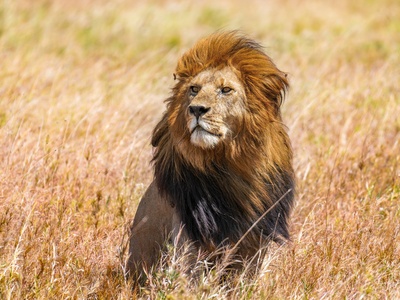
Lion
Africa’s largest cat, weighing up to 250 kg. It is the most social feline, living in prides. Females are the primary hunters, while males with their iconic manes defend the territory. They are most active at dawn and dusk, resting during the day.
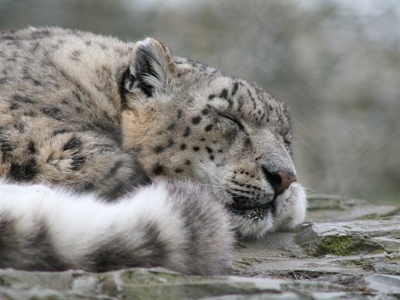
Leopard
A powerful and elusive predator known for its rosette-patterned coat. Leopards are solitary and nocturnal, using their immense strength to hoist kills, sometimes heavier than themselves, into trees to protect them from scavengers like lions and hyenas. They are incredibly adaptable hunters.
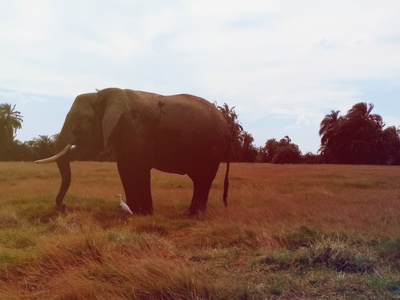
African Elephant
The world’s largest land animal, recognized by its large ears and long trunk. Elephants are highly intelligent and social, living in complex matriarchal family groups. They communicate using a wide variety of low-frequency sounds and play a key role as ecosystem engineers.
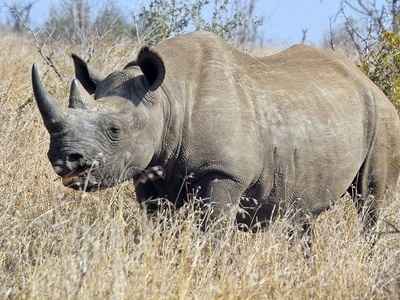
Black Rhinoceros
A large, prehistoric-looking herbivore with two horns and a prehensile upper lip for browsing on shrubs and trees. Critically endangered due to poaching, conservation efforts in Tanzania are crucial for the survival of the eastern black rhino subspecies. They are generally solitary and aggressive.
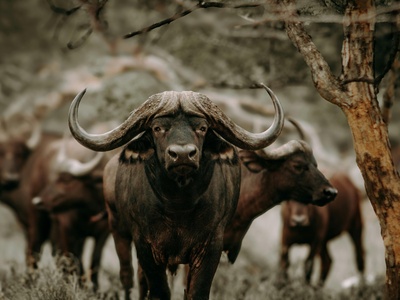
African Buffalo
A large, formidable bovid with distinctive curved horns that form a “boss” on the forehead. Buffalo live in large herds and are known for their unpredictable nature and collective defense against predators. They are bulk grazers, requiring daily access to water.
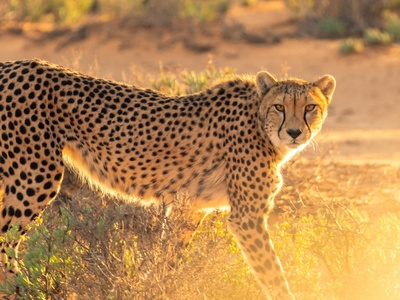
Cheetah
The world’s fastest land animal, capable of speeds up to 120 km/h in short bursts. Recognized by its slender body, spotted coat, and black “tear marks” running from its eyes. Unlike other big cats, cheetahs hunt by day, using speed to catch prey.
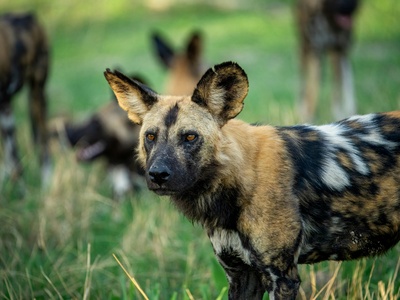
African Wild Dog
A highly social canid with a unique, mottled coat of black, yellow, and white. Wild dogs are formidable cooperative hunters, known for their incredible stamina and high hunt success rate. They live in packs with complex social structures led by an alpha pair.
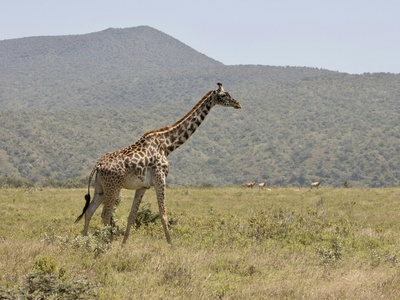
Masai Giraffe
The world’s tallest mammal and Tanzania’s national animal. It has a distinctive coat with irregular, jagged-edged patches. Giraffes are browsers, using their extremely long necks and tongues to reach acacia leaves. Their height provides an excellent vantage point for spotting predators.
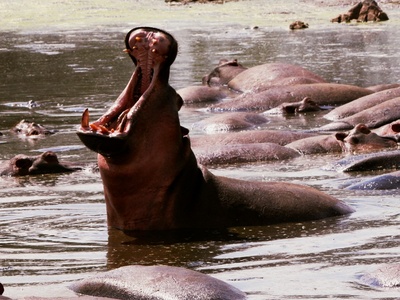
Hippopotamus
A large, semi-aquatic mammal that spends its days submerged in water to stay cool and emerges at night to graze on grasses. Despite their placid appearance, hippos are highly territorial and are responsible for more human fatalities in Africa than any other large animal.
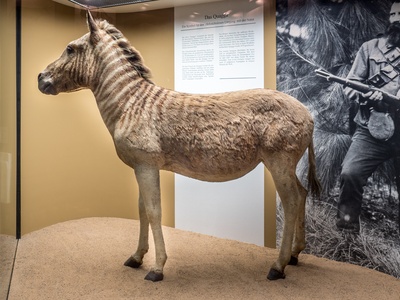
Plains Zebra
Famous for its black-and-white striped coat, with each individual having a unique pattern. Zebras are social animals living in family groups or herds. They are a key species in the Great Migration, constantly moving in search of fresh grazing and water.
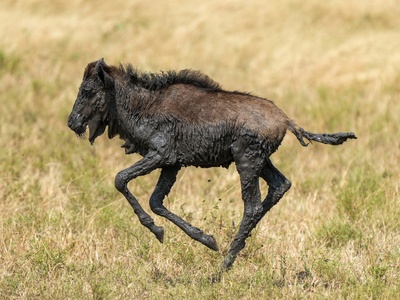
Blue Wildebeest
The cornerstone of the Great Migration, with over 1.5 million migrating annually across the Serengeti ecosystem. These large, bearded antelopes are noisy and social, forming immense herds. They follow the rains, seeking fresh grass for grazing, facing countless predators along the way.
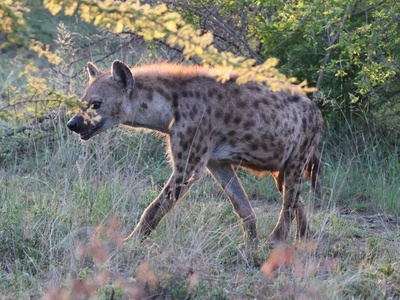
Spotted Hyena
A powerful carnivore with a distinctive sloping back and a famous “laughing” call. Often miscast as mere scavengers, they are highly efficient predators, hunting in large groups called clans, which are led by a dominant female. They possess one of the strongest bites in the animal kingdom.
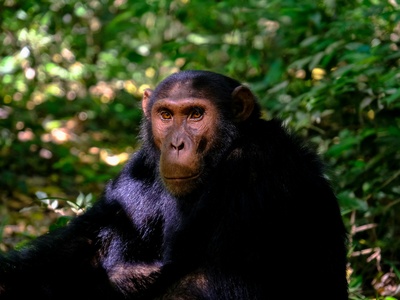
Chimpanzee
Our closest living relative, sharing about 98% of our DNA. Chimpanzees live in complex social communities and are known for their intelligence, communication, and tool use. They are found in the dense forests of western Tanzania, where they are studied extensively.
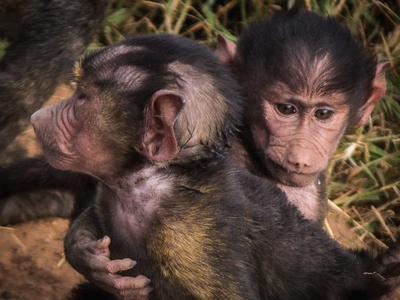
Yellow Baboon
A large monkey with a lanky build and a dog-like muzzle. They live in large, multi-male, multi-female troops and spend much of their time on the ground foraging for roots, seeds, and small animals. Their social interactions are complex and fascinating to observe.
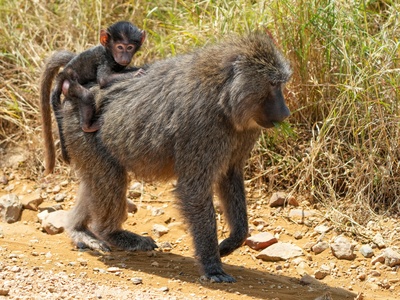
Olive Baboon
Slightly larger and darker than the yellow baboon, with an olive-grey coat. Like their cousins, they are highly social and live in large troops with a strict hierarchy. They are omnivorous and adaptable, often seen foraging along roadsides in northern parks.
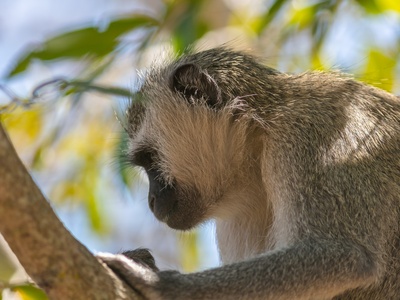
Vervet Monkey
A medium-sized, grey-haired monkey with a black face and a distinctive blue scrotum in adult males. Vervets are highly social and communicative, using different alarm calls to warn of specific predators like leopards, eagles, and snakes. They are commonly seen in safari camps.
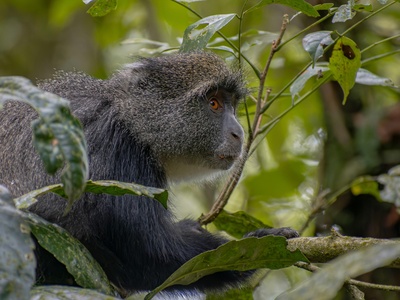
Blue Monkey
Despite its name, this forest-dwelling monkey is mostly grey with a bluish sheen in certain light. It has a prominent white throat and chest patch. They live in female-dominated groups with a single male, feeding primarily on fruit and leaves in the forest canopy.
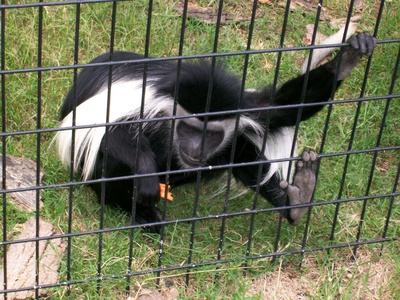
Angolan Colobus
A striking black monkey with long white hair framing its face, a white shoulder mantle, and a bushy white tail tuft. They are arboreal, spending their lives in the treetops feeding on leaves. Their specialized stomach allows them to digest mature or toxic foliage.
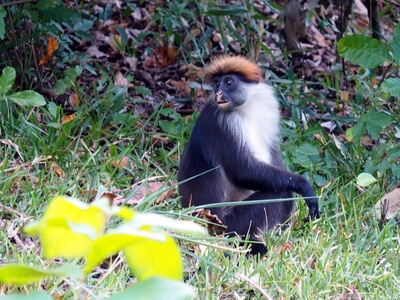
Udzungwa Red Colobus
A rare and beautiful primate endemic to the Udzungwa Mountains. It has a distinct coat with a black back, red limbs, and a white crown. They are leaf-eaters and live in large social groups, often seen leaping gracefully through the forest canopy.
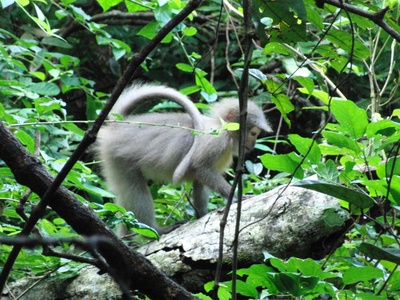
Sanje Mangabey
An extremely rare monkey discovered in 1979 and found only in two forests in the Udzungwa Mountains. It is a large, grey mangabey with prominent white eyelids. They are primarily ground-dwelling, foraging on the forest floor for seeds and fruits.
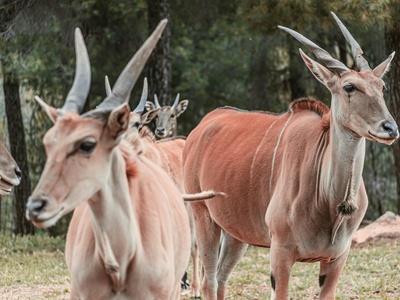
Common Eland
The world’s largest antelope, with a bovine-like build and spiral horns. Despite their size (up to 900 kg), they are surprisingly agile and can jump impressive heights. They live in herds and are both browsers and grazers, adapting their diet to the season.
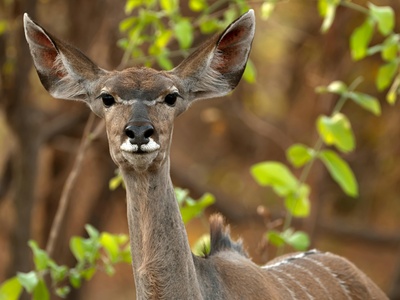
Greater Kudu
A magnificent, large antelope known for the male’s spectacular long, spiral horns. Their grey-brown coat is marked with thin vertical white stripes, providing excellent camouflage in dense bush. They are shy browsers, often seen melting away into the thickets.
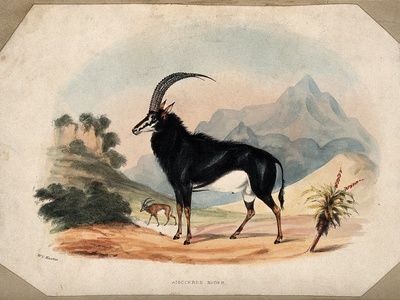
Sable Antelope
A breathtakingly beautiful antelope with a glossy black coat (in males), white underparts, and long, scimitar-shaped horns that curve backward. They are herd animals, preferring open woodlands with tall grass and access to water. The females are a chestnut brown.
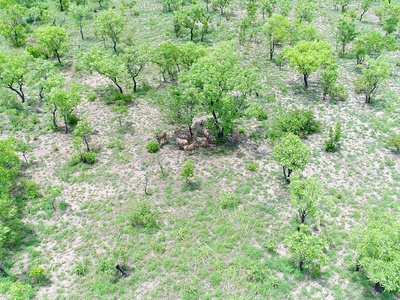
Roan Antelope
A large, horse-like antelope with a greyish-roan coat, a black-and-white facial mask, and long, tufted ears. Their backward-curving horns are shorter but sturdier than a sable’s. They live in small herds and are primarily grazers.
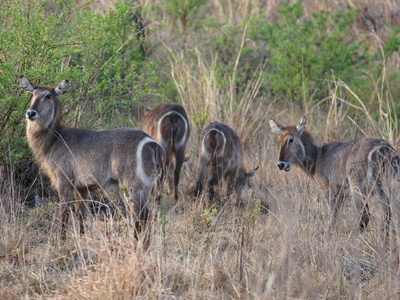
Waterbuck
A large, shaggy-coated antelope easily identified by the white ring around its neck and, in the Defassa subspecies, a white patch on its rump. As their name suggests, they are always found near water, which they use as a refuge from predators.
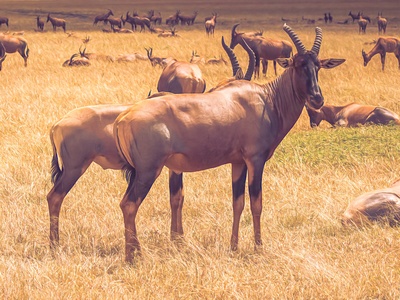
Topi
A medium-sized, highly social antelope with a glossy, reddish-brown coat and distinctive dark purple patches on its upper legs. Topi are known for their habit of standing on termite mounds to survey their surroundings. They are among the fastest antelopes.
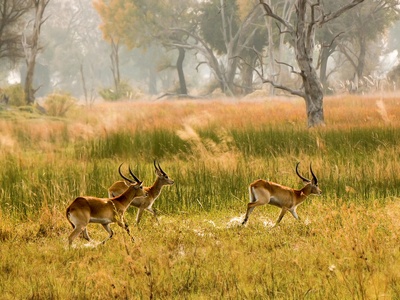
Impala
A graceful, medium-sized antelope. Males have long, lyre-shaped horns. They are known for their incredible leaping ability, used to escape predators. Impalas live in herds and are mixed feeders, both browsing and grazing depending on the season.
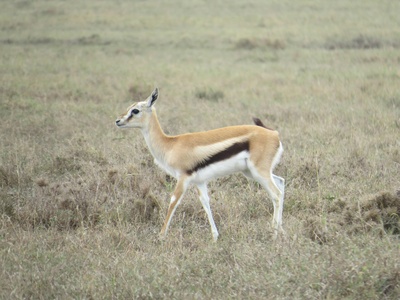
Thomson’s Gazelle
A small, swift gazelle with a light brown coat, a prominent black side stripe, and a constantly flicking tail. They are a common sight on the Serengeti plains and a primary prey species for cheetahs. They form large herds and feed on short grasses and forbs.
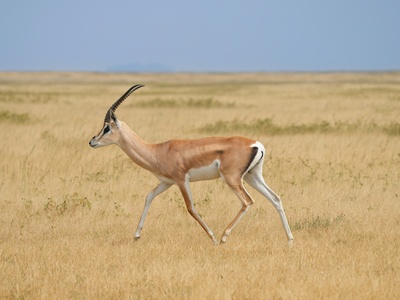
Grant’s Gazelle
Larger and paler than the Thomson’s gazelle, with a less distinct side stripe and a white patch extending above the tail. Males have longer, more robust horns. They are well adapted to dry conditions and can obtain much of their water from the plants they eat.
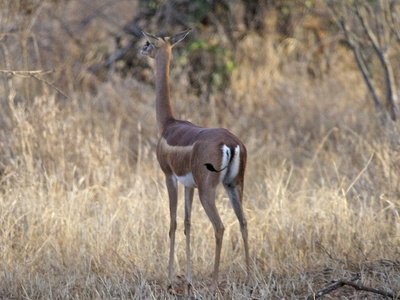
Gerenuk
A unique, long-necked antelope often called the “giraffe-gazelle.” Its most remarkable behavior is standing on its hind legs, using its long neck to browse on high branches that other antelopes cannot reach. They are slender and adapted to arid environments.
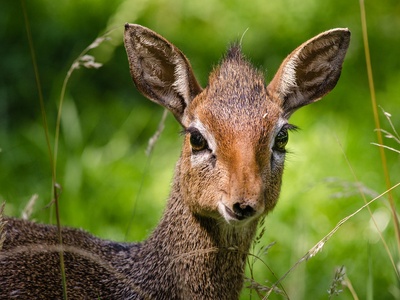
Kirk’s Dik-dik
A tiny, monogamous antelope, standing only 40 cm tall. They have a distinctive elongated, prehensile snout, large eyes, and a crest of hair on their forehead. They are shy and often seen in pairs, darting into thick cover when disturbed.
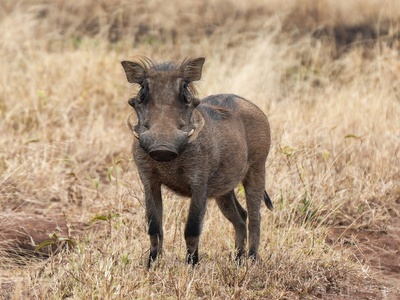
Warthog
An unmistakable wild pig with a large head, upward-curving tusks, and facial “warts.” They are often seen trotting with their tails held straight up like an antenna. Warthogs live in burrows and are commonly seen kneeling on their front legs to graze.
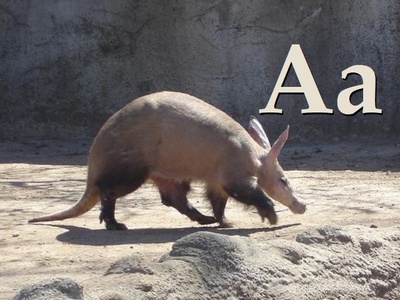
Aardvark
A bizarre-looking, nocturnal mammal with a pig-like snout, rabbit-like ears, and a powerful tail. Aardvarks are specialized insectivores, using their powerful claws to dig into termite mounds and their long, sticky tongue to consume thousands of insects in a single night.
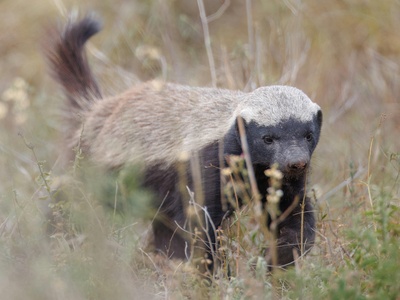
Honey Badger
Renowned for its fearlessness, strength, and tenacity. The honey badger has a striking black-and-white coat, thick, loose skin, and powerful claws. It is an opportunistic carnivore with a broad diet that includes everything from insects and scorpions to snakes and small mammals.
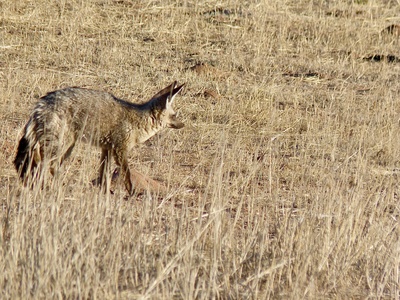
Bat-eared Fox
A small canid distinguished by its enormous ears, which it uses to locate insects underground. Unlike other foxes, their diet consists almost entirely of insects, particularly harvester termites. They are social and are often seen in pairs or family groups foraging together.
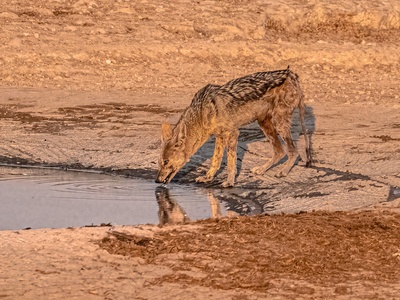
Black-backed Jackal
A slender, fox-like canid with a distinctive black “saddle” flecked with silver on its back. They are highly adaptable and opportunistic, scavenging and hunting small animals, birds, and insects. Their eerie, yapping calls are a characteristic sound of the African night.
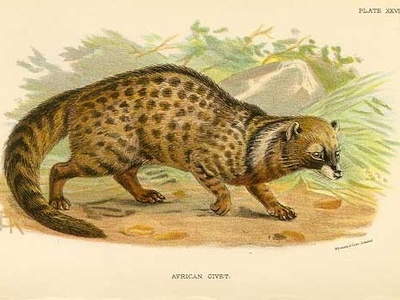
African Civet
A large, solitary, and nocturnal mammal with a unique black-and-white blotched coat and a bushy tail. It produces a strong-smelling musk from its perineal glands, historically used in perfumes. It is an omnivore, feeding on insects, fruit, and small vertebrates.
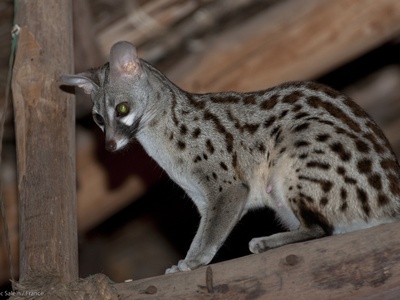
Common Genet
A slender, cat-like carnivore with a spotted coat, a long, ringed tail, and a pointed face. Genets are agile climbers and primarily nocturnal hunters. They prey on small rodents, birds, and insects, often seen moving stealthily through trees or across safari lodge rafters at night.
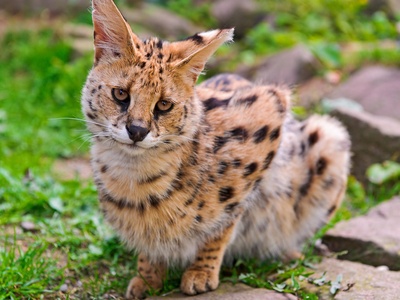
Serval
A medium-sized, long-legged wild cat with a spotted coat and large, rounded ears. Servals are specialist hunters of small mammals and birds in tall grass, using their exceptional hearing to locate prey before pouncing on it from a great height.
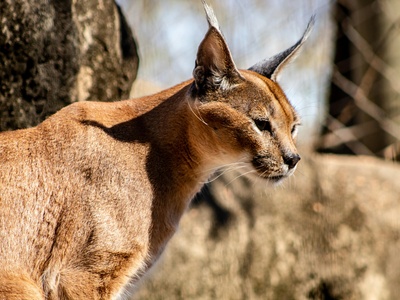
Caracal
A medium-sized, powerfully built wild cat with a reddish-tan coat, long black tufts on its ears, and a short tail. Caracals are formidable hunters, known for their incredible ability to leap high into the air to catch birds in flight.
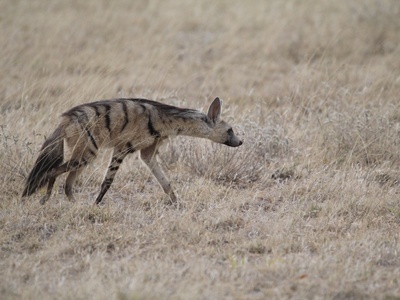
Aardwolf
A hyena relative that, despite its fierce name, is a shy, nocturnal insectivore. It has a striped coat and a mane it can erect when threatened. It does not hunt large prey, instead using its long, sticky tongue to lick up thousands of termites.
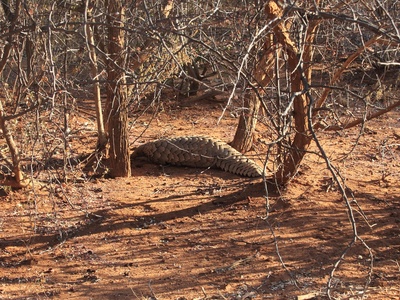
Ground Pangolin
A unique, bipedal mammal covered in overlapping keratin scales. When threatened, it rolls into a tight, armored ball. Pangolins are nocturnal and use their long, sticky tongues to feed exclusively on ants and termites. They are heavily trafficked and highly endangered.
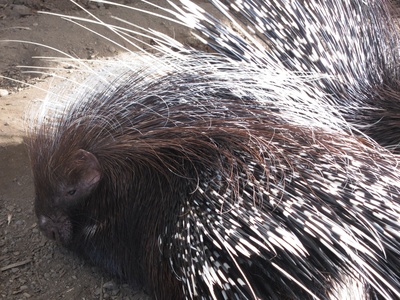
Cape Porcupine
Africa’s largest rodent, covered in long black-and-white quills. These are modified hairs used for defense. When threatened, the porcupine will raise its quills and charge backward to impale a predator. It is nocturnal and feeds on roots, bulbs, and bark.
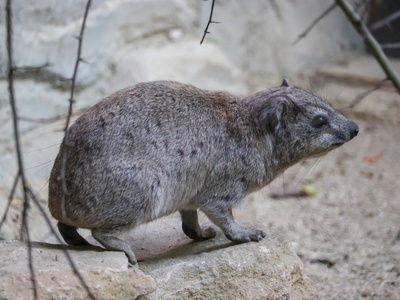
Rock Hyrax
A small, guinea-pig-like mammal that is surprisingly the elephant’s closest living relative. They live in large colonies on rocky outcrops (kopjes), and are often seen basking in the sun. They have specialized, rubbery pads on their feet for gripping rock surfaces.
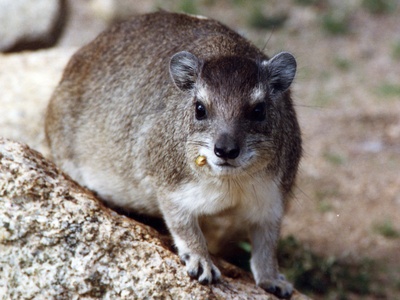
Bush Hyrax
Slightly smaller and more slender than the rock hyrax, with a noticeable white “eyebrow” stripe. It often shares an ecosystem with the rock hyrax and can be seen in the same colonies. They are noisy animals, with a series of sharp calls and shrieks.
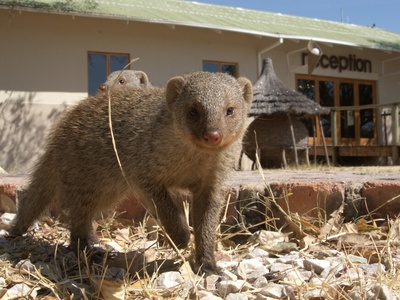
Banded Mongoose
A small, social carnivore with a grey-brown coat marked by dark bands across its back. They live in large troops and are constantly active and vocal, foraging together for insects, millipedes, and small reptiles. They are known for cooperatively mobbing predators.
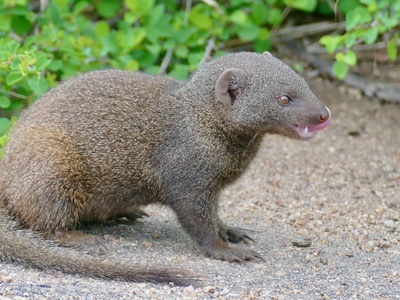
Dwarf Mongoose
Africa’s smallest carnivore, living in social packs of up to 30 individuals. They have a strict hierarchy led by a dominant female. They use abandoned termite mounds as dens and have a mutualistic relationship with hornbills, who warn them of aerial predators.
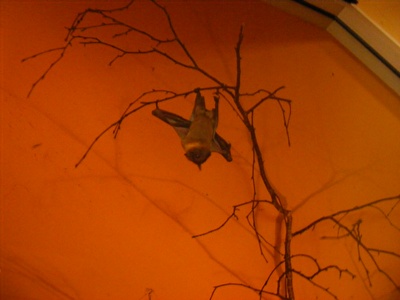
Straw-coloured Fruit Bat
A large fruit bat that forms enormous, noisy colonies, sometimes numbering in the millions. They are crucial for seed dispersal and pollination. They undertake long seasonal migrations, playing a vital role in connecting forest ecosystems across the continent.
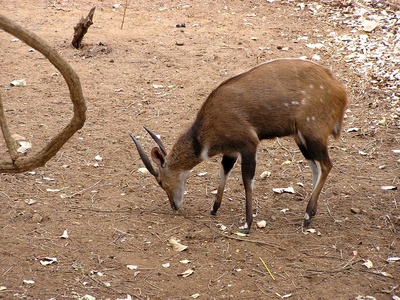
Bushbuck
A medium-sized, shy antelope with a variable coat, typically reddish-brown with white spots and stripes for camouflage. Males have short, sharp, spiral horns. They are solitary browsers, usually found in dense bush, often near water, and are most active at dawn and dusk.
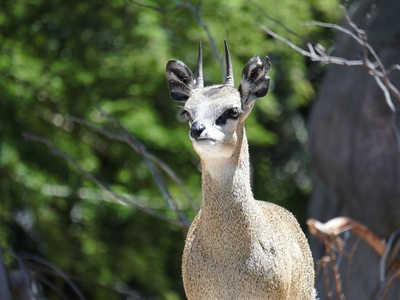
Klipspringer
A small, sturdy antelope uniquely adapted to rocky environments. It walks on the tips of its cylindrical hooves, giving it a sure-footed grip on steep rock faces. They are monogamous and form lifelong pairs, remaining in a small territory.
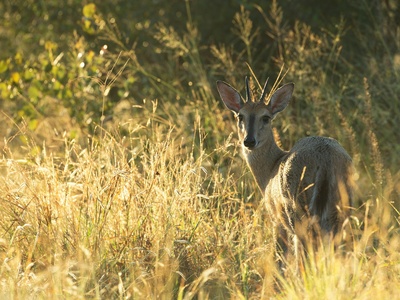
Common Duiker
A small, shy antelope known for its “duking” or diving habit, plunging into thick vegetation when alarmed. They are primarily browsers but are opportunistic feeders. Only males have short, spiky horns. They are typically solitary.
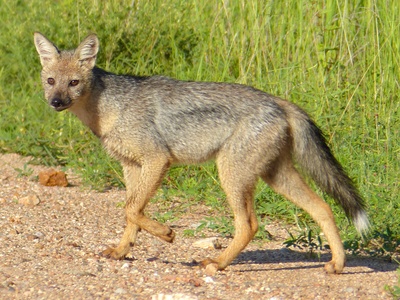
Side-striped Jackal
Distinguished from the black-backed jackal by its greyer coat, a faint white side stripe, and a white-tipped tail. It is more omnivorous and less of a predator, preferring invertebrates and fruit. It favors wetter, more wooded habitats.
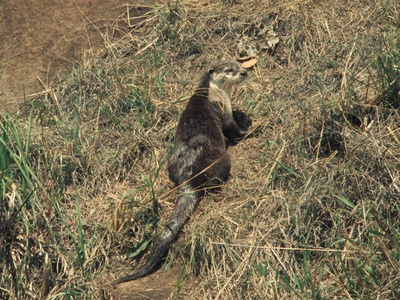
African Clawless Otter
A large freshwater otter lacking claws on its front feet, which have dexterous, hand-like paws used to feel for and catch prey like crabs, frogs, and fish. They are largely nocturnal or crepuscular and are usually seen alone or in small family groups.
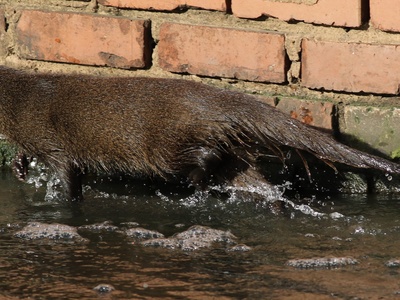
Marsh Mongoose
A medium-sized, dark brown mongoose with a robust build, specialized for a semi-aquatic life. It is a solitary and secretive predator that forages in and around water for crabs, frogs, fish, and other aquatic prey. It is an excellent swimmer.
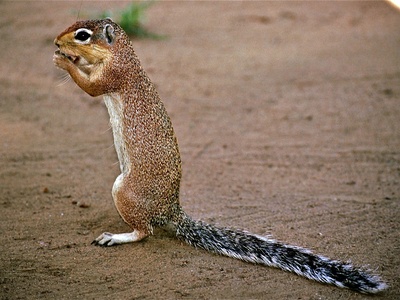
Unstriped Ground Squirrel
A terrestrial squirrel with a bristly, sandy-colored coat and a bushy tail. As its name suggests, it lacks the side stripes of its relatives. It is diurnal and lives in burrows, often seen dashing about with its tail arched over its back.
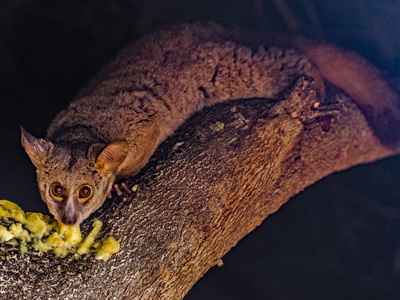
Greater Galago
Also known as the Brown Bushbaby, this is the largest of the galagos. It is nocturnal, with huge eyes, large mobile ears, and a long, bushy tail. It makes a loud, baby-like crying call, which gives the group its “bushbaby” name.
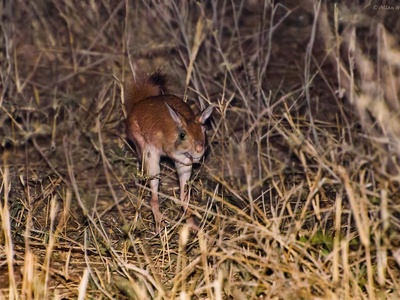
Springhare
A unique rodent that resembles a small kangaroo. It has short front legs, powerful hind legs for hopping, and a long tail for balance. It is nocturnal and lives in extensive burrow systems, emerging at night to feed on grasses and roots.
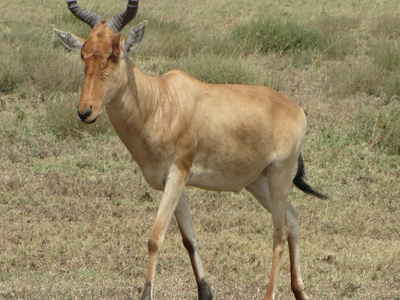
Coke’s Hartebeest
A large, tan-colored antelope with a long, narrow face, high shoulders, and a sloping back. Both sexes have heavily ridged, Z-shaped horns. They are social, living in herds, and are exclusively grazers, often found in the company of wildebeest and zebra.
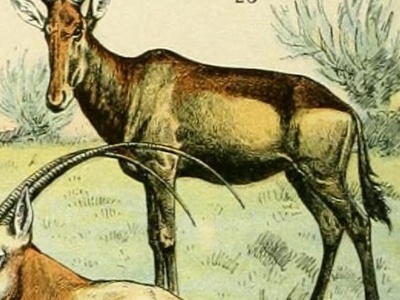
Lichtenstein’s Hartebeest
Distinguished from Coke’s hartebeest by its more reddish, golden-brown coat and different horn shape. It is a grazer that prefers open woodland with access to water. It has a habit of standing on termite mounds to get a better view.
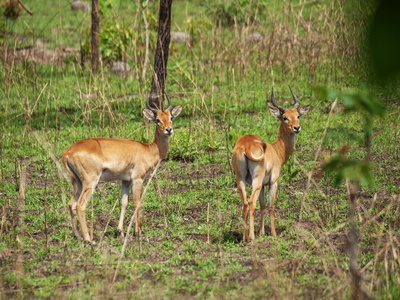
Bohor Reedbuck
A medium-sized, graceful antelope with a yellowish-brown coat. Males have short, forward-curving horns. They are typically found in small groups in tall grasslands or reed beds, which they use for cover, and emit a shrill whistle when alarmed.
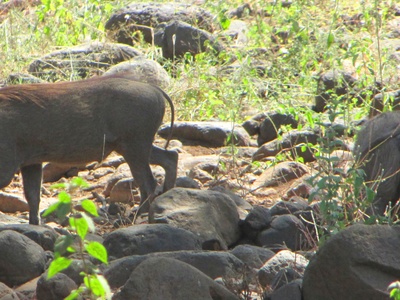
Bushpig
A stocky, powerful wild pig with a shaggy, dark coat and a faint mane. It is more nocturnal and secretive than the warthog. Bushpigs live in social groups called sounders and are omnivores, using their snouts to root for bulbs, roots, and invertebrates.
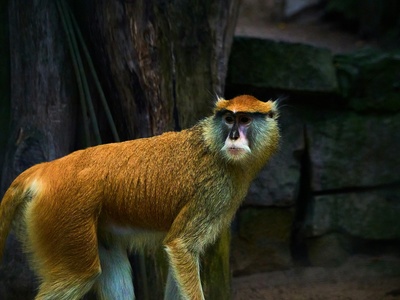
Patas Monkey
Known as the “hussar monkey,” this is the fastest primate, capable of running at speeds up to 55 km/h. It is a ground-dwelling monkey with a lanky build and a reddish-brown coat, adapted to open savanna habitats where it forages for insects, seeds, and tubers.
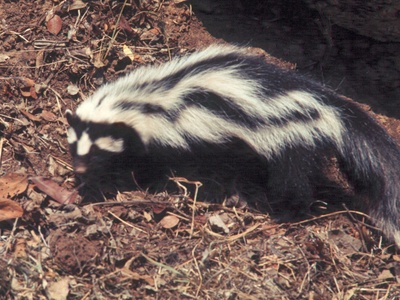
Zorilla
Also known as the striped polecat, this small carnivore resembles a skunk with its bold black-and-white stripes. It is a solitary, nocturnal hunter of small rodents and insects. When threatened, it can spray a foul-smelling liquid from its anal glands.
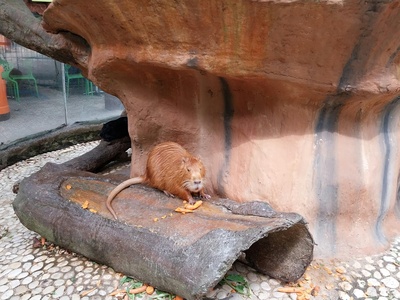
Giant Pouched Rat
A very large African rodent, known for its hamster-like cheek pouches. They are nocturnal and have a poor sense of sight but an exceptional sense of smell. This has allowed them to be trained to detect landmines and tuberculosis, famously by the APOPO project in Morogoro.
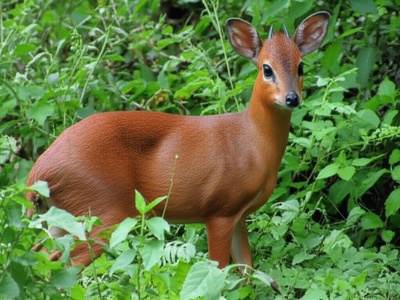
Suni
One of Africa’s smallest antelopes, standing just 35 cm tall. They are incredibly shy and live in dense undergrowth, feeding on fallen leaves and fungi. They are largely nocturnal and “freeze” when threatened, relying on their rufous-brown coat for camouflage.
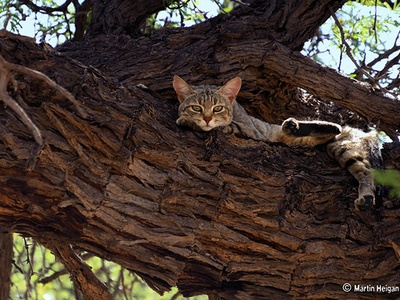
African Wildcat
The ancestor of the domestic cat, the African wildcat is slightly larger and lankier with longer legs. It has a sandy-grey, lightly striped coat that provides excellent camouflage. It is a solitary and mostly nocturnal hunter of small rodents, birds, and reptiles.
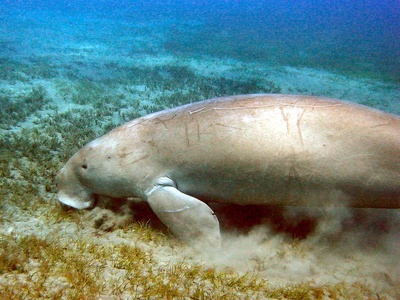
Dugong
A large marine mammal, also known as a “sea cow.” It is a herbivore that feeds exclusively on seagrass in shallow coastal waters. Dugongs are slow-moving and vulnerable to boat strikes and habitat loss. Tanzania’s coast is a critical habitat for this species.
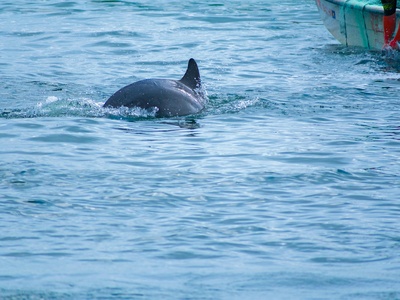
Indo-Pacific Bottlenose Dolphin
A highly intelligent and social marine mammal commonly seen off Tanzania’s coast. They are smaller than the common bottlenose dolphin and often have spots on their undersides as adults. They live in groups called pods and are acrobatic and curious.
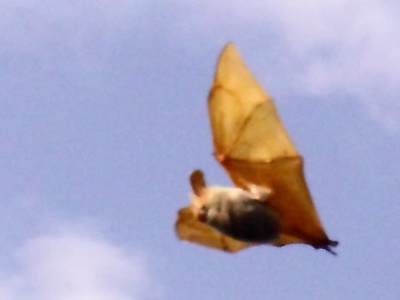
Yellow-winged Bat
A striking “false vampire” bat with pale grey fur, large ears, and distinctive reddish-yellow wings and nose-leaf. It is carnivorous, preying on insects, and is unique among bats for forming monogamous pairs that roost and hunt together.
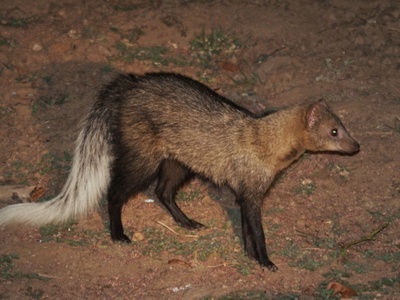
White-tailed Mongoose
A large, long-legged mongoose with a greyish body and a conspicuous long, bushy white tail. It is a solitary, nocturnal hunter that preys on insects, snakes, and small mammals. When alarmed, it raises its tail straight up as a signal.
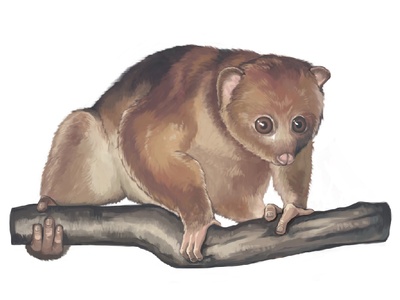
Potto
A nocturnal, slow-moving primate related to lorises. It has a strong grip and moves deliberately through the forest canopy. A unique feature is the shield of bony protrusions on its neck, used for defense. It feeds on fruit, gum, and insects.
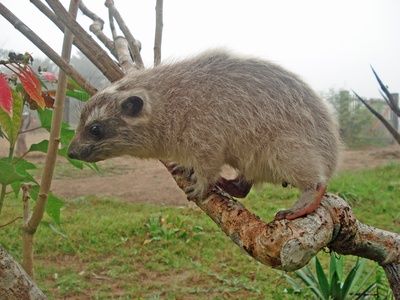
Southern Tree Hyrax
A nocturnal, arboreal relative of the rock hyrax. It is known for its blood-curdling, shrieking call that echoes through the forest at night. It has a dense, soft fur and feeds on leaves and buds in the forest canopy.
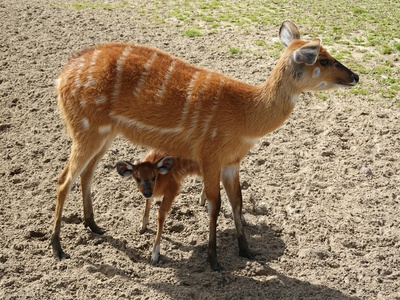
Sitatunga
A semi-aquatic antelope with long, splayed hooves that are specially adapted for walking on soft, marshy ground. It is an excellent swimmer and will submerge itself with only its nostrils showing to escape predators. Males have long, spiral horns.
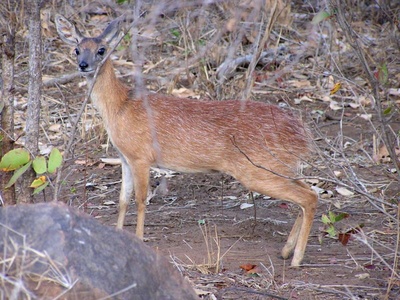
Sharpe’s Grysbok
A small, shy, nocturnal antelope with a reddish coat flecked with white hairs, giving it a grizzled appearance. It is a solitary browser, feeding on leaves and fruits in thick cover. Only the males have short, sharp horns.
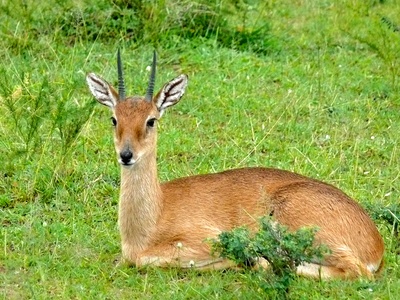
Oribi
A small, slender, and graceful gazelle-like antelope with a long neck and large ears. They are known for their unique “stotting” behavior, where they jump vertically into the air with all four legs stiff when alarmed. They live in pairs or small groups.
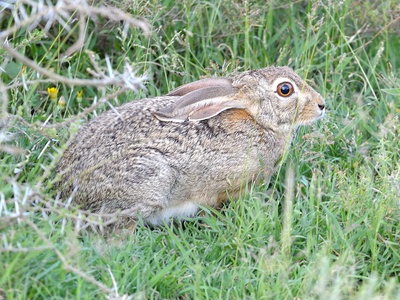
African Hare
A fast-running nocturnal herbivore with long ears, powerful hind legs, and a grizzled grey-brown coat. It relies on its speed and camouflage to escape a wide range of predators. Unlike rabbits, hares are born fully furred and with their eyes open.
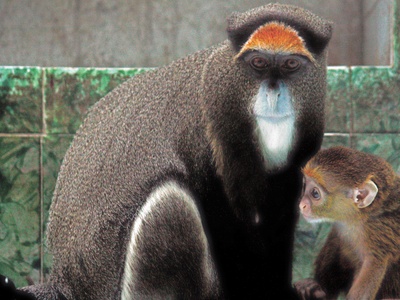
De Brazza’s Monkey
A distinctive and secretive forest monkey with a grey agouti coat, black limbs, a white beard, and a reddish-brown browband. They are semi-terrestrial and excellent swimmers, often found in dense forests close to rivers.
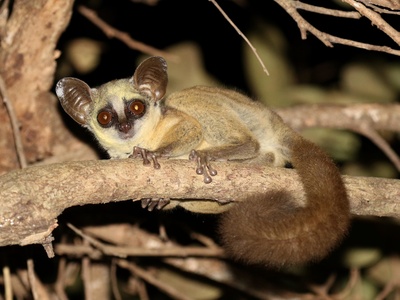
Udzungwa Dwarf Galago
A tiny, nocturnal primate endemic to the coastal forests of Tanzania and the Udzungwa mountains. It has large eyes for night vision and feeds on insects and fruit gum. Its high-pitched calls are a key way to identify it in the dark.
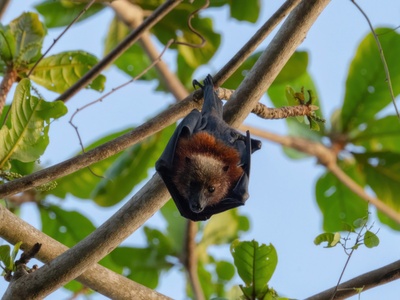
Pemba Flying Fox
A large, magnificent fruit bat found only on Pemba Island. It has a russet-colored body, a fox-like face, and a large wingspan. They are crucial pollinators and live in large, noisy colonies. Conservation efforts have helped their numbers recover.
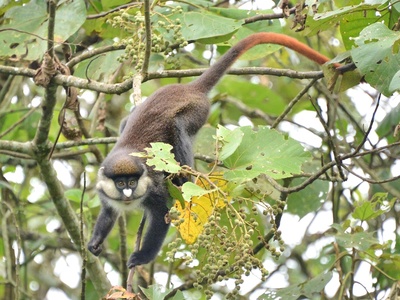
Red-tailed Monkey
A colorful forest monkey with a chestnut-red tail, a white nose spot, and blueish skin around the eyes. They are highly arboreal and live in social groups, often associating with other monkey species. They feed on fruits, insects, and leaves.
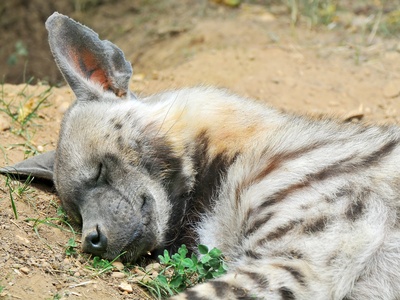
Striped Hyena
Rarer and more slender than the spotted hyena, with a striped coat, a prominent dark mane, and pointed ears. It is primarily a scavenger and is much more solitary. It is nocturnal and elusive, making sightings extremely rare.
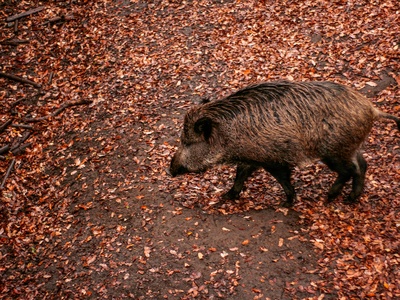
Giant Forest Hog
The largest of all wild pig species. It is a formidable, hairy, black pig with large facial warts, especially prominent in males. They live in small groups and are primarily nocturnal herbivores, feeding on a wide variety of plants.
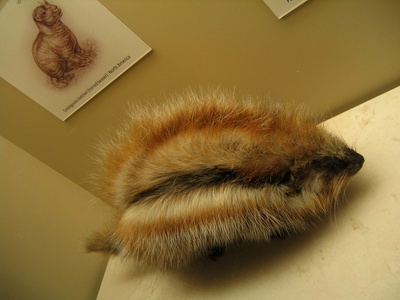
Crested Rat
A unique, porcupine-like rodent with a black-and-white striped mane of erectile hairs on its back. In a remarkable form of defense, it deliberately lathers its specialized hairs with toxins from the poison-arrow tree, making it dangerous for predators to bite.

Jackson’s Mongoose
A rare and poorly understood mongoose, large in size with long, dense fur. It is a nocturnal, terrestrial carnivore believed to specialize in hunting army ants and other insects. It is restricted to high-altitude forests in the Eastern Arc mountains.
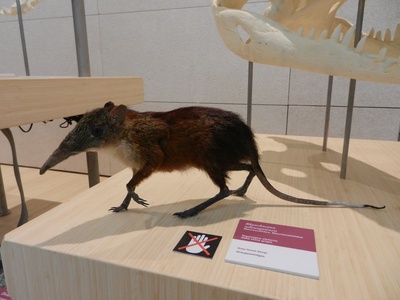
Grey-faced Sengi
A large species of elephant shrew discovered in 2005, endemic to two forests in the Udzungwa Mountains. It has a distinctive grey face and a black lower body. They are insectivores that forage on the forest floor, using their long snouts to probe the leaf litter.
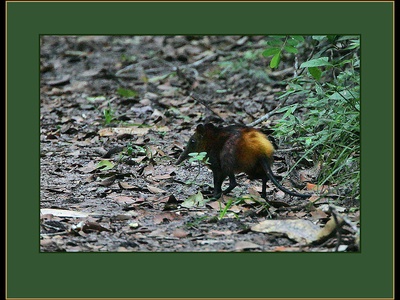
Golden-rumped Sengi
While primarily Kenyan, its habitat extends towards the Tanzanian border. This large elephant shrew has a distinctive golden patch of fur on its rump. It is diurnal and forages for insects on the forest floor, living in monogamous pairs.
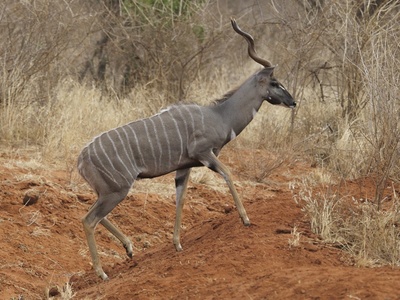
Lesser Kudu
Smaller, more slender, and more striped than its greater cousin, the lesser kudu is a master of camouflage in dense, dry bushland. It is a shy browser that can survive without drinking water, obtaining moisture from the plants it eats.
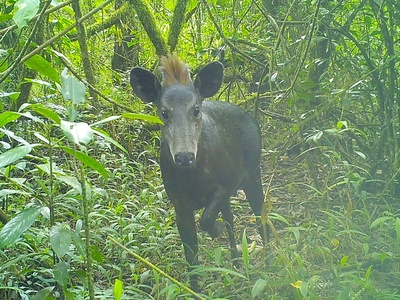
Abbott’s Duiker
A large, dark-colored forest duiker that is endemic to a few isolated mountains in Tanzania. It is a shy and elusive herbivore, living in dense, high-altitude forests, making it extremely difficult to study and rarely seen by visitors.
